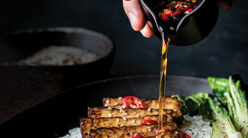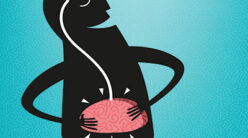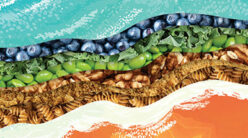What’s Causing Your Cravings?
It’s a common assumption that cravings indicate a nutritional need (for example, a chocolate craving means your body needs magnesium). But while this explanation is appealing, the real story is more complicated, says Marcia Pelchat, Ph.D., a food cravings expert at the Monell Chemical Senses Center.
It’s true that you’re more likely to have cravings if you’re anemic, but usually, the foods that people crave aren’t foods that will supply the nutrient they actually need. The classic example is the craving for ice: it’s frequently the result of an iron deficiency, but ice doesn’t actually contain iron. Furthermore, studies conducted by Pelchat and her colleagues have shown that even people who are getting a nutritionally complete diet can still have cravings.
Odds are, then, that your hankering isn’t a signal that your body needs nutrients. In reality, says Pelchat, most cravings are actually a learned response. If you have a habit of eating potato chips while watching TV, for example, you may develop a craving for that food every time you sit down to catch a show. In fact, you might come to crave potato chips even if you don’t actually like them.
“What happens with food cravings of all kinds is that environmental cues become associated with consuming a certain food,” she says. “Whenever those cues are encountered, the craving is triggered.” Like an alcoholic who gets clean in rehab, you can be craving-free when you’re away from your triggers. But as soon as you’re back in contact with the triggers, you’ll be tempted to succumb again. And, unfortunately, since cravings are learned desires that don’t necessarily stem from hunger, they can kick in even when you’ve just eaten (like with the craving for ice cream after dinner).
Although habit plays a large role in cravings, stress can make the yearnings worse. Researchers from the University of California at San Francisco found that placing rats in a high-stress environment prompted them to begin engaging in pleasure-seeking behaviors, such as eating high-fat and high-sugar foods. Eating those foods, in turn, helped calm the rats and stop the release of stress hormones. It’s likely, then, that humans also eat certain foods when we’re under stress because those foods help relax us—even while they have less-than-positive effects on our waistlines and other aspects of our health.
But habit and stress aren’t the only factors behind cravings. Believe it or not, new research suggests that the bacteria in our gut also play a role. According to Athena Aktipis, Ph.D., assistant professor of psychology at Arizona State University, various microbes in our intestines feed on different kinds of nutrients (such as fat or sugar). It appears that these microbes actually send signals to our brains prompting us to eat the foods that they thrive on. Studies have shown that our gut microbes can change our test receptors, influencing our preference for those foods; and they are also capable of releasing toxins into our bodies that affect our moods if they are not receiving the nutrients they want. “They benefit if we eat the foods they depend on,” explains Aktipis.
In other words, when we’re fending off a craving, we’re not just struggling against ourselves. “We might actually be fighting against some other source that doesn’t have our best interest at heart,” says Aktipis.
Your Plan of Attack Against Cravings
Trying to eliminate all cravings all the time is probably a lost cause, according to Jessica Setnick, a registered dietitian and a senior fellow at Remuda’s Ranch eating disorder treatment center. But although the desires may never completely go away, there are a variety of ways to keep the cravings at bay. Here are a few:
1. Remove your triggers.
For some people, cravings are triggered by sight: if they see the food sitting out on the kitchen counter or on the corner of their desk, they’re more likely to snack. Put problem foods behind closed doors, says Pelchat—or better yet, keep them out of the house altogether. If you know you have to go out to get your ice cream fix, you’re more likely to enjoy it as a small, occasional treat than if there’s a half gallon of mint chocolate chip in your freezer.
2. Don’t let yourself get too hungry.
If you avoid eating during the day in an effort to lose weight, you’re bound to have powerful hormones that will make you more likely to binge by dinnertime. “You’re more apt to be able to avoid eating high-fat, high-sugar foods if you have filled yourself up on healthier foods during [meals],” says Caroline Apovian, M.D., director of the Nutrition and Weight Management Center at Boston Medical Center.
3. Distract yourself.
A successful distraction can be as simple as tapping your forehead or your ear, or imagining a blank wall. Researchers from Mt. Sinai St. Luke’s Hospital in New York City found that doing any one of these activities for just 30 seconds helped to diminish food cravings. And even if you eventually come back and eat the food you were craving, the mere act of delaying the inevitable can help weaken the craving in the future, says Pelchat.
4. Starve the microbes.
If our gut bacteria are partly to blame for our Twinkie and Frito obsessions, then giving in will only expand the population of microbes that depend on those foods, making the cravings worse, explains Aktipis. “If we want to stop craving foods that are so bad for us, perhaps the most important thing to do is to cut back on those foods,” she says. That means cutting back not just on the particular food that you crave, but on high-fat, high-sugar foods in general.
5. Eat breakfast—and make it protein-rich.
Researchers from the University of Missouri found that people who ate a morning meal had dramatically fewer cravings for both sweet and salty foods during the day, with breakfasts high in protein being the most effective. For great plant-based sources of breakfast protein, load up on nut butters, scrambled tofu, quinoa and other whole grains, or even beans (yes, they’re good for breakfast!).
6. Opt for portion-controlled packaging.
In this case, says Pelchat, you’re not erasing a craving, but you’re at least controlling mindless eating and limiting your intake of unhealthy foods.
7. Name the deeper reason for your craving.
In many cases, says Setnick, cravings reflect emotional needs, so it’s helpful to put a label on them. For example, you might crave chocolate chip cookies because you miss your mom and the times you used to bake together. Once you know the underlying emotional need, you can approach it more productively.
8. Journal your desire.
Put down on paper all the reasons why you want to eat a particular food, says Setnick. Perhaps the food is luxurious or comforting. Once you’ve finished journaling, go back and cross out the name of the food itself and read your writing back to yourself to find out what you’re really seeking. If it’s luxury, indulge in a manicure instead; if it’s comfort, try a warm bath.






